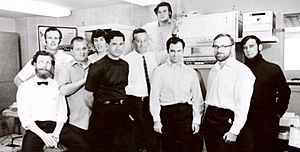Frank Heart facts for kids
Quick facts for kids
Frank Heart
|
|
|---|---|

IMP Team (left to right): Truett Thatch, Bill Bartell, Dave Walden, Jim Geisman, Robert Kahn, Frank Heart, Ben Barker, Marty Thorpe, Will Crowther, and Severo Ornstein
|
|
| Born |
Frank Evans Heart
May 15, 1929 New York City, U.S.
|
| Died | June 24, 2018 (aged 89) Lexington, Massachusetts, U.S.
|
| Alma mater | Massachusetts Institute of Technology |
| Occupation | Computer engineer |
| Employer |
|
| Known for | Co-designing the IMP |
| Spouse(s) |
Jane Sundgaard
(m. 1959; died 2014) |
| Children | 3 |
| Awards | Internet Hall of Fame (2014) |
Frank Evans Heart was an American computer engineer. He was born on May 15, 1929, and passed away on June 24, 2018. He was a key person in developing early computer networks. After working at MIT Lincoln Laboratory for almost 15 years, Heart joined Bolt, Beranek and Newman (BBN) in 1966. At BBN, he led a team that designed the very first computer for the ARPANET. The ARPANET was a network that came before the Internet we use today.
Contents
Frank Heart's Early Life and Education
Frank Heart grew up in Yonkers, New York. His family was Jewish. His father was an engineer, and his mother worked in insurance.
In 1947, Heart started studying electrical engineering at the Massachusetts Institute of Technology (MIT). He was part of a special five-year program. During this time, he would switch between working and going to school each semester. One summer, he tested power transformers at a factory.
In 1951, he took a new computer programming course at MIT. This course made him finish his first degree early. For his advanced studies, Heart helped with a computer called Whirlwind I. This computer was used to control a radar system that tracked airplanes. Whirlwind I later moved to the MIT Lincoln Laboratory. Heart earned both his bachelor's and master's degrees in electrical engineering in 1952.
Building the Internet's First Routers
After finishing his degrees, Frank Heart stayed at Lincoln Lab. He became a team leader for projects that built real-time computer systems. These systems collected data from measuring devices using phone lines connected to computers.
In 1966, Heart left Lincoln Lab to work for Bolt, Beranek and Newman (BBN). BBN was a company focused on research and development. In August 1968, BBN won a contract from ARPA. Their job was to build the first Interface Message Processor (IMP). An IMP was a special computer that sent data and connected different parts of a network. Today, we call these devices routers. Frank Heart was chosen to manage this important project.
Designing the IMP Computer
Frank Heart's team had ten engineers. Severo Ornstein led the hardware part, and Will Crowther led the software part. They used a strong Honeywell DDP-516 minicomputer to build the IMP. The IMP's main job was to switch data between the computers on the ARPANET.
The team also invented a way to fix computers from far away. They added remote control features to the IMPs. By September 6, 1968, Heart's team finished their IMP proposal. It was almost 200 pages long and cost $100,000. This was BBN's most expensive project at that time.
The First IMPs Go Live
The very first IMP was set up at the University of California, Los Angeles (UCLA) on September 1, 1969. A month later, on October 1, the second IMP was installed at the Stanford Research Institute in Menlo Park, California.
Frank Heart was known as a great project manager at BBN. His teams worked well together because everyone was focused on the same goal. They took personal responsibility for their work. Heart believed that reliability was more important than cost or speed. He wanted his teams to create working products, not just simulations. By 1971, Heart's IMP team grew to 30 people. They started using a lighter Honeywell 316 for the IMPs.
In 1972, Frank Heart appeared in a documentary about the ARPANET. It was called Computer Networks: The Heralds of Resource Sharing.
The Legacy of the IMPs
The ARPANET was officially stopped by the government in 1989. Most of the IMPs were taken apart. However, a few of them are still in museums and computer labs today. Many of Frank Heart's ideas, like making sure systems are reliable and can fix errors, are still part of the Internet. Frank Heart's last job at BBN was president of the systems and technology division. He retired from BBN in the summer of 1994.
In 2014, Frank Heart was honored for his work. He was added to the Internet Hall of Fame.
Frank Heart's Personal Life
Frank Heart met Jane Sundgaard while working at Lincoln Laboratory. She was one of the first women programmers at the company. They got married in 1959 and had three children. The family lived in Lincoln, Massachusetts, during Heart's career at BBN. Jane Heart passed away in 2014. Frank Heart died on June 24, 2018, at the age of 89. He passed away from melanoma in a retirement community in Lexington, Massachusetts.

